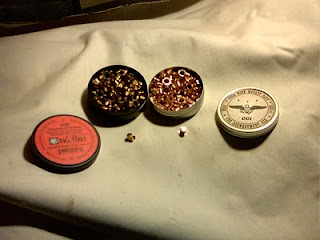All the sutlers at the Jackson, Michigan event last year that had percussion caps for sale sold the German RWS caps for about $12 for a can of 100 caps. However, most of these sutlers also had the new CCI 4-wing percussion caps designed for reenactors at $10 for a can of 100—and one sutler sold the caps for $8 for a can.
When the CCI 6-wing caps were available we avoided them—even prohibiting their use—due to their firing hot and ripping apart. The flying metal could risk injuring a fellow reenactor.
With these new 4-wing caps sold at a significantly cheaper price, I considered it worth investigating into the feasibility of using these as replacements for the German caps. I purchased one tin for testing.
I fired about 10 caps in Christine (my Springfield), priming only. All showed the same consistency in firing, and all stayed together. They seemed to pop about the same as a German cap, perhaps even slightly less, which brought up concerns of possibly misfiring in battle. However, during Sunday’s battle, up until I was taken out by that cannon, I used the CCI caps exclusively and did not have a single misfire—and all caps continued to show the same pattern after detonation that the prime-only firing showed the night before.
 |
| Musket percussion caps. On the left are the standard German RWS caps, while the right are the new 4-wing CCI caps. |
Therefore, it is my recommendation that we accept the CCI 4-wing Percussion Caps for Reenactors as an alternate and less expensive choice to the German RWS caps.
EDIT (05/24/2011):
In my analysis of the Navy Arms caps (here), I said I would also test the 4-wing CCI caps with a double load, like I did for the failed Navy Arms caps. At the Sunbury, OH I had my opportunity. I fired a double load off with a 4-wing CCI cap, and its behavior was similar to the German caps--no tearing or fragmentation. Therefore I am sticking with my recommendation that the 4-wing CCI caps are safe.
As an additonal note--for funsies, I tested a 6-wing CCI cap with a double load. I had never really done any kind of testing of the 6-wing caps--I had simply always been told that these can be dangerous and fragment badly, and took everyone's word for it. The 6-wing CCI cap does pop quite a bit hotter (ear protection is recommended, even when firing with no powder), but I was quite surprised to find that it did not fragment under such a charge. (I use about 65 grain in my charges, so this was exposed to about 130 grain.) Granted, I only tested one cap--perhaps this was an exception, but I'd have to say that it is safer to use a 6-wing CCI than it is to use the 4-wing Navy Arms caps. Still, unless I can see a signficant number tested with no tearing or fragmentation, I'd be much more comfortable knowing the guy next to me was not using them.
EDIT (09/20/2011):
After having used these caps for a season along with fellow reenactors, I have this small update: the caps tend to leave some excessive residue upon firing. I don't have much of a problem with this as my nipple has a good sized hole, but others with Enfields and a significantly smaller hole through their nipple have complained of excessive misfires due to this extra residue. I have had occasional unexplained misfires that could be attributed to the excessive residue. Fortunately for me, Christine is pretty good about getting over it--once she gets hot, she almost never misfires.
EDIT (05/24/2011):
In my analysis of the Navy Arms caps (here), I said I would also test the 4-wing CCI caps with a double load, like I did for the failed Navy Arms caps. At the Sunbury, OH I had my opportunity. I fired a double load off with a 4-wing CCI cap, and its behavior was similar to the German caps--no tearing or fragmentation. Therefore I am sticking with my recommendation that the 4-wing CCI caps are safe.
As an additonal note--for funsies, I tested a 6-wing CCI cap with a double load. I had never really done any kind of testing of the 6-wing caps--I had simply always been told that these can be dangerous and fragment badly, and took everyone's word for it. The 6-wing CCI cap does pop quite a bit hotter (ear protection is recommended, even when firing with no powder), but I was quite surprised to find that it did not fragment under such a charge. (I use about 65 grain in my charges, so this was exposed to about 130 grain.) Granted, I only tested one cap--perhaps this was an exception, but I'd have to say that it is safer to use a 6-wing CCI than it is to use the 4-wing Navy Arms caps. Still, unless I can see a signficant number tested with no tearing or fragmentation, I'd be much more comfortable knowing the guy next to me was not using them.
EDIT (09/20/2011):
After having used these caps for a season along with fellow reenactors, I have this small update: the caps tend to leave some excessive residue upon firing. I don't have much of a problem with this as my nipple has a good sized hole, but others with Enfields and a significantly smaller hole through their nipple have complained of excessive misfires due to this extra residue. I have had occasional unexplained misfires that could be attributed to the excessive residue. Fortunately for me, Christine is pretty good about getting over it--once she gets hot, she almost never misfires.